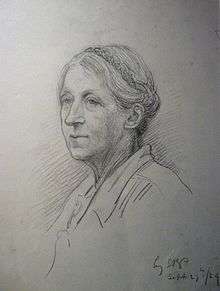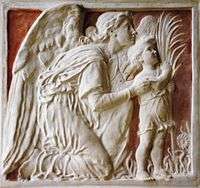Ellen Mary Rope
Ellen Mary Rope (1855–1934) was a British sculptor whose long career stretched from 1885 until the early 1930s. Her work is notable for its range of expression and style, from the classical to the popular. She worked chiefly in bas-reliefs, in stone, cast metal or plaster.[1]
Ellen Mary Rope | |
|---|---|
 Pencil portrait of the sculptor in her old age, by Rosamond Praeger | |
| Born | 14 March 1855 Blaxhall, England |
| Died | 13 September 1934 Blaxhall, England |
| Nationality | English |
| Education | Attended Slade School of Art from 1877 |
| Alma mater | Slade School of Fine Art |
| Known for | Sculpture |
Notable work | Bas-reliefs in metal and plaster; also decorative ceramics |
Life
Born the seventh child of George and Anne Rope of Blaxhall, Suffolk, Ellen Mary Rope is said to have displayed strong artistic leanings as a child, maybe under the influence of her eldest brother, George Thomas Rope, a landscape painter and naturalist. To foster this interest, she was sent to London in 1870 to study at Nottingham Place School in Marylebone, where she was taught drawing by Octavia Hill.[2] She later returned to her home village and attended Ipswich School of Art, taught by among others William T. Griffiths, the principal. Her first exhibited works were paintings and drawings of similar rural subjects to her brother, who exhibited alongside her. She returned to London to the Slade School of Fine Art in 1877, continuing to study drawing and painting but in 1880 Professor Alphonse Legros introduced a course in sculpture and modelling, which Rope followed to good effect, radically influencing the direction of her artistic career.[3] Her art developed along classic Arts and Crafts lines, with emphasis on the artist's involvement throughout the creative process and manual not mechanised production. Rope was based in London for most of her professional career, latterly in Deodar Road, Putney, where she shared accommodation and a studio with her assistant Dorothy Anne Aldrich Rope, a niece. In the same road was the stained-glass studio of another niece M. E. Aldrich Rope, not to be confused with a third artistic niece Margaret Agnes Rope.
Ellen Mary Rope only fully retired to the family home at Grove Farm in Blaxhall soon before her death in 1934.
Works
Her first piece at the Royal Academy of Arts was a terracotta panel: "David playing before Saul" (1885). From that date she had works at R.A. Exhibitions in most years up until 1918. By 1893 she was sufficiently well known to be commissioned to provide four plaster relief figures for spandrels in the Woman's Building (Chicago) of the World Columbian Exposition in Chicago.[4] Each polychrome panel was nearly six feet tall, and represented Faith, Hope, Charity and Heavenly Wisdom. As well as exhibition pieces, she had a more commercial strand to her art, becoming a leading designer for the Della Robbia Pottery from 1896 until its closure in 1906. This led to more popular domestic works featuring children, flowers and the sea.[5] These small panels "were primarily designed to be executed at low cost and repeated if desired, so that they could be used by others than the very rich"[6] However, major architectural commissions continued, including large figures of Faith, Hope and Charity for Morley Town Hall, Leeds (since lost), a 20' long panel for Rotherhithe Town Hall (destroyed by wartime bombing), and a memorial executed in cement at St Mary's, Bolton-on-Swale.[7] Her association with the Garrett circle, dating back to childhood, led to her spandrels from Chicago being installed in the dining room of Chenies Street Ladies' Residential Chambers (a project of cousins Rhoda and Agnes Garrett) and later to the marble memorial to the mother of Elizabeth Garrett Anderson in Aldeburgh parish church. Earlier, in 1894, another Garrett associate, Octavia Hill, had commissioned bas-reliefs by Rope for the drawing room of the Women's University Settlement in Nelson Square, Blackfriars.[8]
References
- "Chapter3:"The Poet Sculptor" by Rope, A.". Blaxhall's Creative Past. Blaxhall. pp. 71–106. ISBN 9780955538933.
- "Magazine of Art: "The Art Movement: The Work of Miss Ellen M. Rope" by "A.F."". 1900. p. 324. Cite magazine requires
|magazine=(help) - Ellen Mary Rope: The Poet Sculptor by Barnes,J., Fagence, S., Heywood, L., & Levy, M. published by H. Blairman & Sons. London. 1997. p. 4. ISBN 0952329263.
- Nichols, K. L. "Women's Art at the World's Columbian Fair & Exposition, Chicago 1893". Retrieved 12 December 2018.
- "Chapter3:"The Poet Sculptor" by Rope, A.". Blaxhall's Creative Past. Blaxhall. pp. 71–106. ISBN 9780955538933.
- "Article". The Builder: 508. 3 December 1898.
- "Chapter3:"The Poet Sculptor" by Rope, A.". Blaxhall's Creative Past. Blaxhall. pp. 71–106. ISBN 9780955538933.
- Crawford, Elizabeth (2002). Enterprising Women: The Garrets and their Circle. London: Francis Boutle Publishers. pp. 288–292. ISBN 1903427126.
"The New Sculpture" by Beattie, S., Yale University Press, London, 1983
"Miss Ellen Rope, Sculptor" by Kendall, B., in The Artist, December 1899, pp. 206–212
"The Art of E.M.Rope" by Maclean, F.J., in The Expert, July 13, 1907, pp. 251–2
Gallery
 R.A.exhibit 1885 - "David playing before Saul", terracotta panel
R.A.exhibit 1885 - "David playing before Saul", terracotta panel Marble bas-relief probably of the Virgin Mary
Marble bas-relief probably of the Virgin Mary Christchild with contemporary children, and lilies: a typical later theme, reused in several locations
Christchild with contemporary children, and lilies: a typical later theme, reused in several locations Plaster panel in her local parish church, St Peter's, Blaxhall, Suffolk
Plaster panel in her local parish church, St Peter's, Blaxhall, Suffolk "Patience and Hope steering the Boat of Education", plaster panel
"Patience and Hope steering the Boat of Education", plaster panel